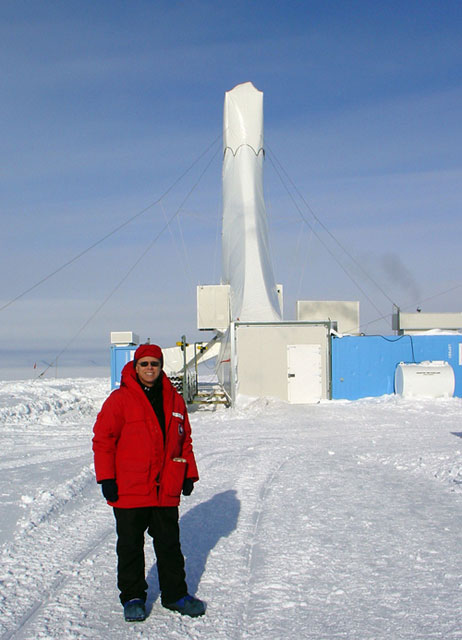|
Magical realismWISSARD project poised to explore subglacial Lake WhillansPosted November 9, 2012
It’s taken a bit of magic — not to mention an incredible effort by scientists, engineers and support personnel — but the WISSARD The biggest research program of the post-International Polar Year (IPY) The official name — Whillans Ice Stream Subglacial Access Research Drilling — only offers a hint about what this $10 million interdisciplinary project funded by the National Science Foundation “We’re going into the unknown — one of the last frontiers — which makes it really exciting,” said John Priscu 
Photo Courtesy: John Priscu/Antarctic Photo Library
John Priscu, with the Royal Society Range in the background.
The project is actually made up of three components, an alphabet soup of acronyms that captures the various research goals within WISSARD. Priscu also leads GBASE “We’re ready for almost anything,” Priscu said of the search for life underneath the ice sheet. Next up is LISSARD “Basically, it provides a lubrication for ice motion,” explained Slawek Tulaczyk The third component has the fiercest acronym, RAGES A professor at Northern Illinois University “There’s complexity in developing the technology to do that,” Powell said in what could be considered something of an understatement. A subglacial wetlandsThere’s certainly nothing understated in what WISSARD proposes to accomplish in its multiyear study, particularly in the opening chapter that begins with the 2012-13 summer field season. Even now, U.S. Air Force C-17 Globemaster III The dress rehearsal includes everything from the complex hotwater drill system that will bore a hole through the ice sheet, to the instruments that will collect water and sediment samples from Lake Whillans, to the clean-access protocols that will help ensure the research doesn’t contaminate the lake. Then it will be time to pack it all up and haul sleds of equipment across the Texas-sized Ross Ice Shelf “The United States has a history of working there,” said Priscu of a region where ice streams, faster-moving rivers of ice within the ice sheet, drain into the Ross Ice Shelf. For example, remote sensing work by WISSARD colleagues like Helen Fricker “The subglacial environment is like a wetland, with the rivers coming through … with fairly large but shallow lakes that flow into other lakes,” Priscu explained. Land o' lakesLake Whillans is one of about a half-dozen subglacial lakes known to exist under the ice streams near the Ross Ice Shelf. A series of previous studies — some directly in support of WISSARD, others predating it — have found that Lake Whillans is about 60 square kilometers but only about 10 meters deep. In particular, WISSARD’s geophysical team has worked over the past few years to provide the borehole science group with unequivocal data on lake hydrology and morphometry, according to Priscu. “Thanks to the excellent work by our geophysical team, we now know more about the basin characteristics of subglacial Lake Whillans than we do about lakes in the McMurdo Dry Valleys, which have been studied for more than 30 years,” he said. Several hundred subglacial lakes have been identified since they were first discovered in the 1970s. Researchers with the British Antarctic Survey (BAS) The largest and most famous remains Lake Vostok, which Russian scientists penetrated earlier this year after decades of drilling through the East Antarctic Ice Sheet, originally as part of ice-core research. A recent analysis from samples of lake ice stuck to the drill did not find any signs of life from Vostok, located more than 4,000 meters below the ice. That hasn’t surprised scientists, who say the sample was likely contaminated by petroleum-based fluid used to cool the drill and keep the hole open. [See previous article — Breakthrough: Russian scientists penetrate subglacial lake for the first time.] 1 2 3 Next |



For USAP Participants |
For The Public |
For Researchers and EducatorsContact UsU.S. National Science FoundationOffice of Polar Programs Geosciences Directorate 2415 Eisenhower Avenue, Suite W7100 Alexandria, VA 22314 Sign up for the NSF Office of Polar Programs newsletter and events. Feedback Form |




